
The Solar-Terrestrial Centre of Excellence (STCE) is a collaborative network of the Belgian Institute for Space Aeronomy, the Royal Observatory of Belgium and the Royal Meteorological Institute of Belgium.
 |
Published by the STCE - this issue : 9 Jan 2015. The Solar-Terrestrial Centre of Excellence (STCE) is a collaborative network of the Belgian Institute for Space Aeronomy, the Royal Observatory of Belgium and the Royal Meteorological Institute of Belgium. |
| Archive of the newsletters | Subscribe to this newsletter by mail |
Well, maybe it was a bit late to spectacularly launch the New Year, but at least in the northern part of the Netherlands some faint but colorful polar light could be seen low above the northern horizon on 4 January around 18:00UT. The aurora didn't last long, barely 10 minutes, but Vincent van Leijen (https://www.flickr.com/photos/fotovins/16017690757/in/photostream/) still managed to snap this great picture.
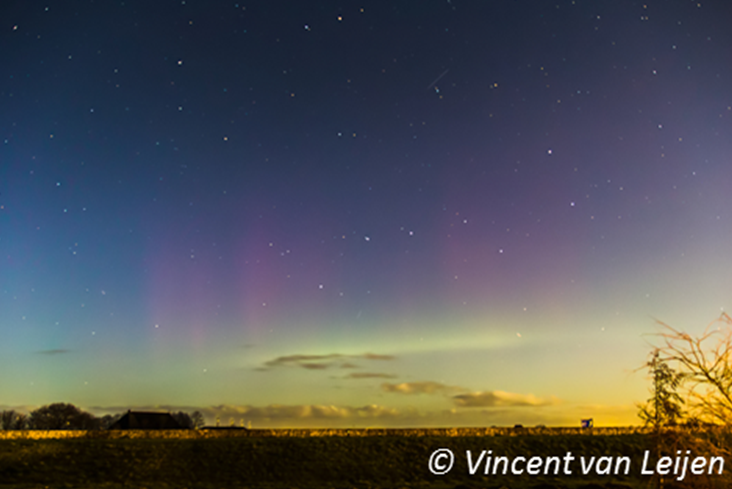
The source of the geomagnetic field disturbance was the high speed stream of a coronal hole that transited the south-central part of the solar disk just a few days before (see SDO-images underneath). Interestingly, this coronal hole was also responsible for a similar disturbance ("minor geomagnetic storm") during its previous transit early December.
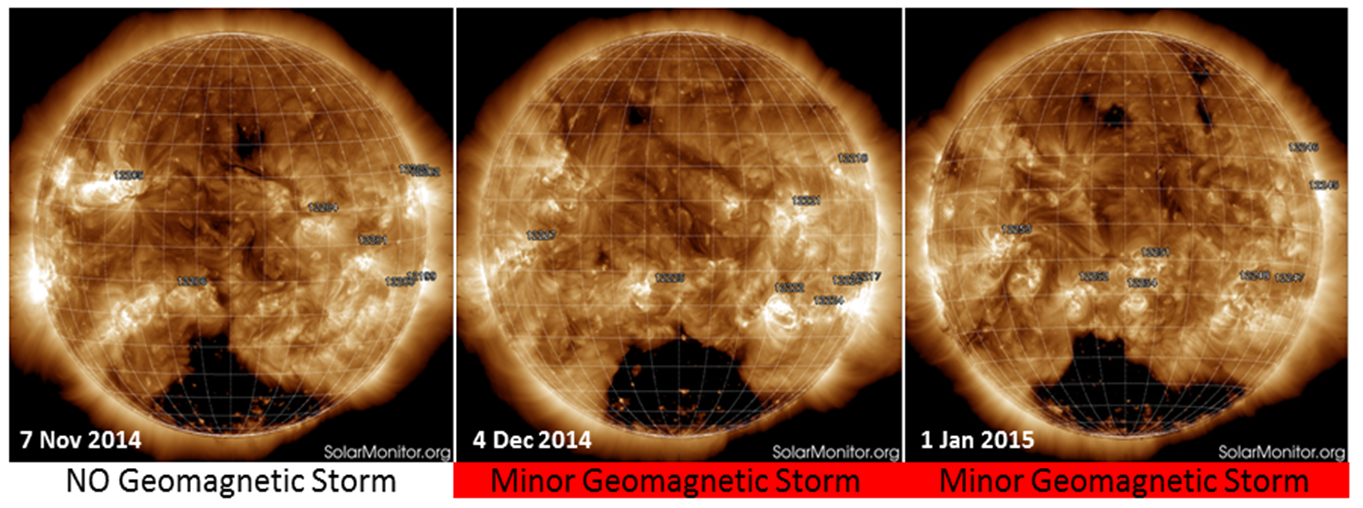
There are several reasons why the polar light in this picture seems rather faint, for example when compared to a similar display on 12 September 2014 (see this news item at http://stce.be/news/268/welcome.html). At that time, it concerned a major geomagnetic storm (one of the strongest of 2014), so significantly more intense than the 4 January display. More importantly, the 4 January picture was taken early evening, when it was not yet completely dark. Last but not least, there was also a Full Moon around those days, resulting in even more unwanted bleach on the picture.
A total of 34 C- and 2 M-class flares were recorded over the period.
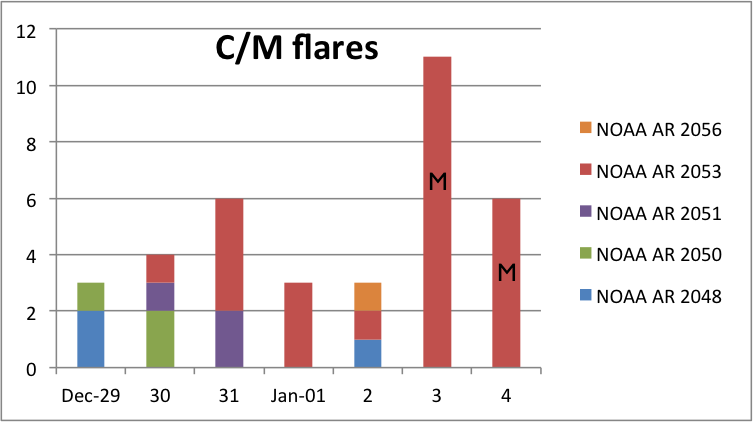
NOAA 2253 was the most prominent region of the week, containing a delta structure in its leading portion from 01 till 04 January. The picture below the photospheric (HMI instrument onboard SDO), coronal (SDO/AIA) and magnetic (SDO/HMI magnetogram) semblance of NOAA 2253 on 03 January. It was the source of 25 C-class flares and also the two M1 flares, resp. on 03 January peaking at 09:47UT (M1.1) and on 04 January at 15:36UT (M1.3).
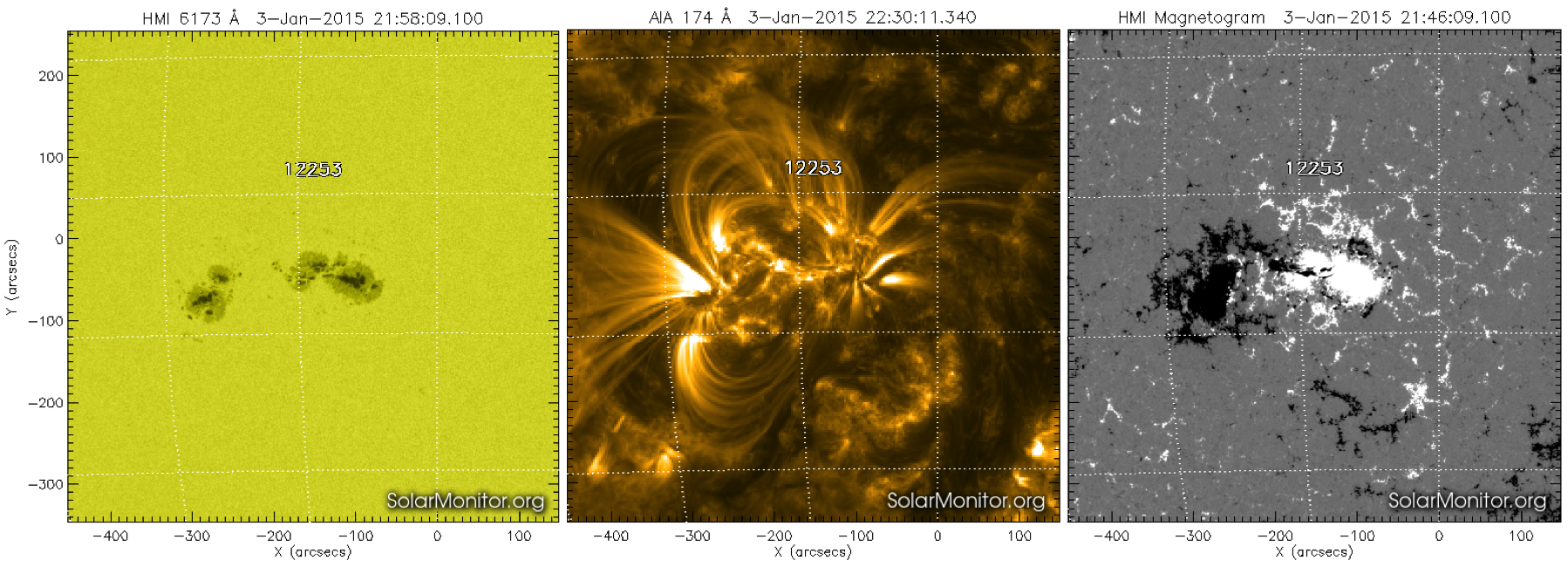
Active regions NOAA 2248, NOAA 2250 and NOAA 2251 contributed each with 3 low-level C-class flares.
The greater than 10 MeV proton flux was at nominal levels. No significant or earth-directed CMEs were observed over the entire week.
| DAY | BEGIN | MAX | END | LOC | XRAY | OP | 10CM | TYPE | Cat | NOAA |
| 03 | 0940 | 0947 | 0950 | S4E17 | M1.1 | 1N | 57 | 2253 | ||
| 04 | 1518 | 1536 | 1553 | S7E2 | M1.3 | 2N | 2253 |
| LOC: approximate heliographic location | TYPE: radio burst type |
| XRAY: X-ray flare class | Cat: Catania sunspot group number |
| OP: optical flare class | NOAA: NOAA active region number |
| 10CM: peak 10 cm radio flux |
High Speed Streams (HSS) from various coronal holes influenced the geomagnetic field. This resulted in minor geomagnetic storming on 29-30 December and again on 04-05 January.
During the first period, solar wind speed reached values near 750 km/s, with Bz wildly fluctuating between -11 and +11 nT.
The second period saw the recurring effects from the extension of a southern polar coronal hole that was also responsible for a minor geomagnetic storm during its previous transit early December. The pictures below is taken by SDO/AIA and shows the southern polar coronal hole on 01 October 2014, 08 November 2014, 05 December 2014 and 01 January 2015.

Solar wind speed gradually increased to values around 550 km/s, preceded by a sustained period of negative Bz up to -10 nT. Geomagnetic conditions were quiet to unsettled for the rest of the week, with the exception of a brief active episode at Dourbes late on 02 and early on 03 January (est. Kp at minor storm level). The IMF was directed towards the Sun until 01 January, after which periods of "towards" oriented IMF alternated with episodes of "away" orientation. The pointing of the IMF "Towards" or "Away" is measured by ACE IMF Phi, i.e. the angle of the IMF in the XY plane. If Phi is between 270 and 360 degrees, the IMF points "Towards", if Phi is between 90 and 180 degrees, the IMF points "Away".
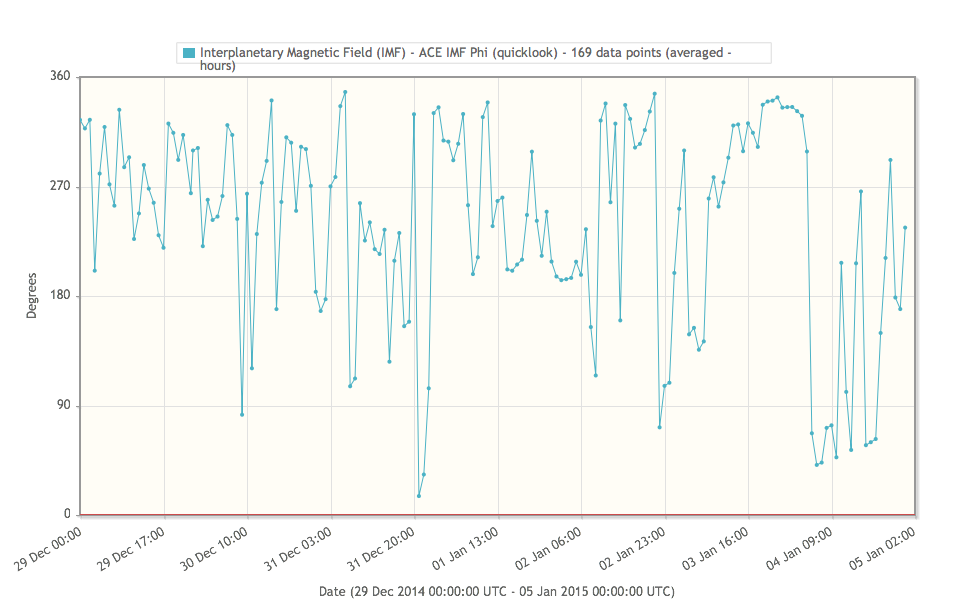
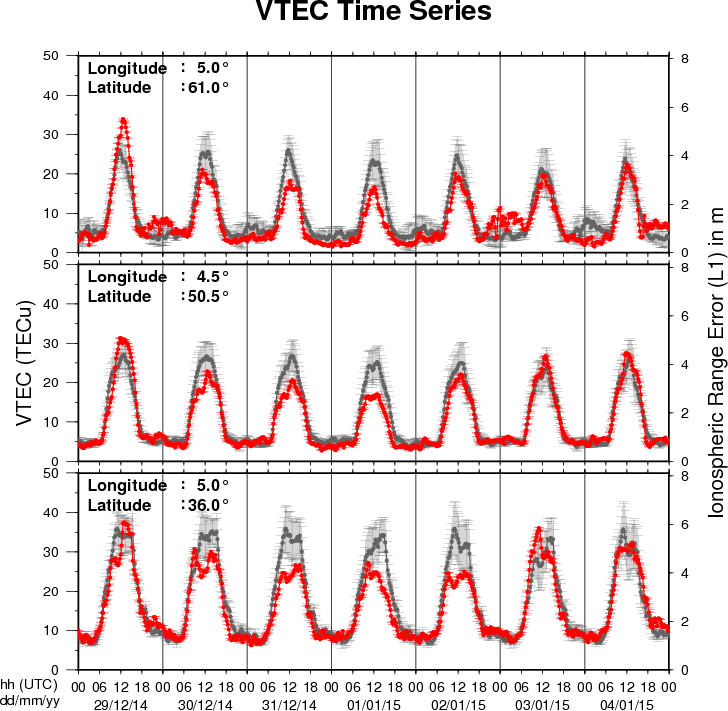
The figure shows the time evolution of the Vertical Total Electron Content (VTEC) (in red) during the last week at three locations:
a) in the northern part of Europe(N61°, 5°E)
b) above Brussels(N50.5°, 4.5°E)
c) in the southern part of Europe(N36°, 5°E)
This figure also shows (in grey) the normal ionospheric behaviour expected based on the median VTEC from the 15 previous days.
The VTEC is expressed in TECu (with TECu=10^16 electrons per square meter) and is directly related to the signal propagation delay due to the ionosphere (in figure: delay on GPS L1 frequency).
The Sun's radiation ionizes the Earth's upper atmosphere, the ionosphere, located from about 60km to 1000km above the Earth's surface.The ionization process in the ionosphere produces ions and free electrons. These electrons perturb the propagation of the GNSS (Global Navigation Satellite System) signals by inducing a so-called ionospheric delay.
See http://stce.be/newsletter/GNSS_final.pdf for some more explanations ; for detailed information, see http://gnss.be/ionosphere_tutorial.php
Start : 2015-03-16 - End : 2015-03-19
This international conference will provide an overview of our
current understanding of Sun-Climate Connections starting at
processes on the Sun itself over space weather and solar wind
towards solar influence on the upper atmosphere down to the ocean.
It will also provide insights into the heatedly debated role of the
Sun in climate change. In four sessions the various contributions
of solar variability influence on Earth's climate will be presented
and discussed by bringing together solar physicists, space
scientists, atmospheric scientists, climate modellers, and
paleoclimatologists.
We expect contributions from scientists participating in
SCOSTEP/ROSMIC, SPARC-SOLARIS/HEPPA, the EU cost network TOSCA, as
well as any other interested scientists. The conference will last
three full days, beginning Monday morning, 16 March 2013. The
programme will consist of invited and keynote lectures, a few
contributed oral presentations and ample time dedicated to poster
sessions. The fourth day will be devoted to public outreach
activities as well as panel discussions.
Website: http://scc.geomar.de/
Start : 2015-05-18 - End : 2015-05-22
URSI AT-RASC 2015 will be the first edition of the newly
established triennial URSI Atlantic Radio Science Conference as one
of the URSI Flagship Conferences. AT-RASC 2015 will have an open
scientific program composed of submitted papers within the domains
covered by all ten Commissions of URSI.
Website: http://www.at-rasc.com/
Start : 2015-06-01 - End : 2015-07-24
The Space Weather Summer School at Los Alamos National
Laboratory, established in 2011 under the founding Director Josef
Koller, is dedicated to space weather, space science and
applications. Every year we solicit applications for the Los Alamos
Space Weather Summer School. This summer school is sponsored and
supported by a number or organizations at LANL. This year our top
sponsors include the Los Alamos Institute of Geophysics, Planetary
Physics and Signatures (IGPPS) and the Laboratory Directed Research
and Development Office (LDRD). The summer school brings together
top space science students with internationally recognized
researchers at LANL in an educational and collaborative
atmosphere.
Website:
http://www.swx-school.lanl.gov/
Start : 2015-07-21 - End : 2015-07-23
The conference will review past and recent achievements, as well
as future challenges in the field of solar coronal loop
physics.
Website:
http://www.damtp.cam.ac.uk/user/astro/cl7/index.html
Start : 2015-07-28 - End : 2015-08-04
Heliophysics is all of the science common to the field of the
Sun-Earth connections. This fast-developing field of research
covers many traditional sub-disciplines of space physics,
astrophysics, and climate studies. The NASA Living with a Star
program, with its focus on the basic science underlying all aspects
of space weather, acts as a catalyst to bring the many research
disciplines together to deepen our understanding of the system of
systems formed by the Sun-Earth connection.
Website:
http://www.heliophysics.ucar.edu/
Start : 2015-07-30 - End : 2015-08-06
The 34th International Cosmic Ray Conference (ICRC) will be held
from July 30 to August 6, 2015, in The Hague, The Netherlands. It
is an important and large conference in the field of Astroparticle
Physics. The ICRC covers: cosmic-ray physics, solar and
heliospheric physics, gamma-ray astronomy, neutrino astronomy, and
dark matter physics.
Website: http://icrc2015.nl
Start : 2015-10-05 - End : 2015-10-09
This CSPM-2015 scientific meeting will cover various aspects of
solar dynamic and magnetic phenomena which are observed over the
entire electromagnetic spectrum: white-light, Hα, Ca II,
and radio from ground and in a variety of other wavelengths (white
light, UV and EUV, and X-rays) from space. Emphasis will also be
placed on instrumentation, observing techniques, and solar image
processing techniques, as well as theory and modelling through
detailed radiative transfer in increasingly realistic MHD models.
The long-term (cyclic) evolution of solar magnetism and its
consequence for the solar atmosphere, eruptive phenomena, solar
irradiation variations, and space weather, will be in focus. Here,
special attention will be devoted to the long-term observations
made in Coimbra and also to the results of the SPRING / SOLARNET
and SCOSTEP VarSITI studies. In particular, the weak solar activity
during the current solar maximum will be discussed. Finally, since
this meeting is organised around the 90th anniversary of performing
the first spectroheliographic observations in Coimbra, a session
will be specially dedicated to new solar instruments (both
ground-based and space-borne) that will give access to unexplored
solar atmospheric features and dynamic phenomena over the coming
years.
Website:
http://www.mat.uc.pt/~cspm2015/
Start : 2016-07-30 - End : 2016-08-07
The 41st COSPAR Scientific Assembly will be held in Istanbul,
Turkey from 30 July - 7 August 2016. This Assembly is open to all
bona fide scientists.
Website:
https://www.cospar-assembly.org/